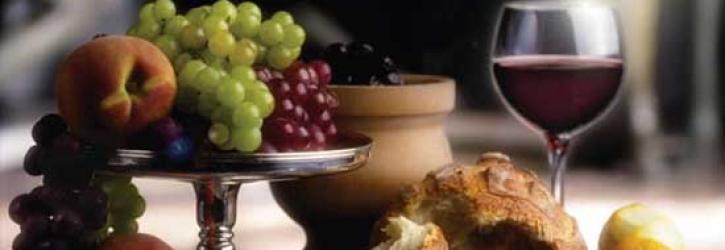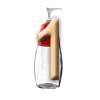 |
Scrub A Dub. Wash your hands often. Wash with warm, soapy water before preparing any food and after handling raw meats, poultry or fish. Good hand washing could eliminate nearly half of all cases of foodborne illness. |
 |
Keep Your Kitchen Clean. To prevent the growth of bacteria, it's important to keep all kitchen surfaces clean including your appliances, countertops, cutting boards and cooking utensils. Wash kitchen surfaces with hot, soapy water and a commercial sanitizing agent. |
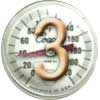 |
Keep Foods Out of the Danger Zone. Germs which cause foodborne illness grow rapidly between the temperatures of 40 degrees and 140 degrees Fahrenheit. Keep cooked and ready-to-eat foods cold below 40 degrees. Cook all foods well. Check your refrigerator temperature regularly with an appliance thermometer. |
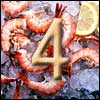 |
Keep Cold Foods Cold. Foods should be kept at 40 degrees or below to prevent the growth of harmful bacteria. Use an appliance thermometer to check the temperature of your refrigerator at home. Place raw meat, poultry and seafood in the coldest part of your refrigerator. Check refrigerator temperature regularly to ensure food safety and quality. |
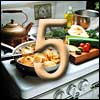 |
Keep Hot foods Hot. Foods which are being served hot should be held above 140 degrees Fahrenheit to prevent the growth of bacteria. Reheated foods should be brought to a temperature of at least 165 degrees. |
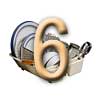 |
Don't Cross-Contaminate. Use separate cloths, sponges and towels for washing dishes, wiping counters and tables and wiping hands. Clean dishes should be air-dried. These practices will prevent cross-contamination with harmful bacteria. |
 |
Segregate Stored Foods. Keep raw meats and juices away from foods that are ready-to-eat to prevent cross-contamination. Store raw meats and poultry at the bottom of the refrigerator so that they don't drip on other foods. |
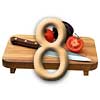 |
Code Your Cutting Boards. Use two cutting boards in your kitchen; one to cut raw meats, poultry and seafood and the other for ready-to-eat foods like breads, fruits and vegetables. This will prevent cross-contamination of harmful bacteria from raw foods to those that are ready-to-eat. |
 |
Wash Your Produce. Remove soil and residue from fresh fruits and vegetables by washing them thoroughly under cold running water prior to serving. Trim any bruised areas before eating. This will reduce the risk of consuming harmful bacteria which may be present naturally in the environment. |
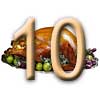 |
Cook Your Foods Well. Use a meat thermometer to determine proper doneness of cooked meats and poultry. Cook whole poultry to 180 degrees Fahrenheit, ground turkey and chicken to 165 degrees, ground beef, lamb, veal or pork to 160 degrees and eggs or egg dishes to 160 degrees. Meat roasts and steaks to 145 degrees. Fish should be cooked until it flakes easily. |
 |
Serve Food Safely. Foods should not be left at room temperature (the DANGER ZONE) for more than two hours at a time to prevent the growth of harmful bacteria. Cover and chill foods quickly in shallow dishes after serving. |
 |
Defrost Your Foods Safely. Foods can be safely defrosted in the refrigerator, under cold running water, or in the microwave oven. Never at room temperature. |
 |
Marinate Foods Safely. Foods can be safely marinated in a covered glass or metal bowl in the refrigerator - not on the counter. |
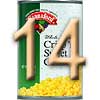 |
Choose Canned Goods with Safety In Mind. Purchase canned goods with the packaging intact; cans should not be bulging, leaking or dented on the seal or rim. |
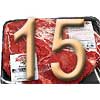 |
Store Food Safely. Store opened food in foil, plastic wrap, leak proof plastic bags or airtight containers to keep food safe and high in quality. Label and date foods using a first in, first out process. |
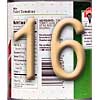 |
Read the Label. Read the product label carefully for food handling instructions including storage and code dates. Never store any foods labeled "Keep refrigerated" in the pantry. Look for "best if used by" or "use by" dates for optimum quality and safety. |
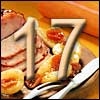 |
When in Doubt, Throw it Out. Label and date foods stored in your refrigerator and freezer. Leftovers that are not used within 3-4 days should be discarded. |
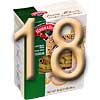 |
Pantry Safety Tip. Shelf-stable pantry items should be stored in a clean, dry, cool area (below 85 degrees) away from the stove or the refrigerator's exhaust for best quality and safety. Check your pantry regularly for pests. |
 |
Double Up on Cooking Utensils. Use separate cooking utensils and platters when putting raw meats on the grill and taking cooked meats off the grill to prevent cross-contamination with harmful bacteria. |
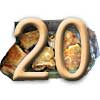 |
Chill Foods Well. Chill hot foods safely by using shallow dishes (no deeper than 2 inches) that will cool food quickly to prevent the growth of bacteria. Keep foods out of the temperature danger zone (40 degrees to 140 degrees Fahrenheit). |
 |
Store Cleaning Supplies Safely. Store chemicals in their original containers and out of the reach of small children. Keep cleaning supplies in a dry, locked cabinet or in areas away from food products or other chemicals with which they may react. |
 |
Sanitize Your Kitchen Sponges. Heat a wet kitchen sponge in a microwave-safe dish in the microwave oven for approximately 2 minutes so that it achieves an internal temperature of 160 degrees to kill harmful bacteria. |
 |
Be Careful Mixing. Never mix fresh prepared foods with leftovers or raw foods with those that have been already cooked. This increases the chance for contamination of harmful bacteria. |
 |
Use Pasteurized Eggs. When preparing recipes that include raw eggs which will not be cooked or will not be cooked to at least 145 degrees Fahrenheit use pasteurized eggs. Always discourage tasting of batter or dough that contains raw eggs. |
 |
Taste Safely. When tasting food, ladle a small amount of it into a dish and taste it with a clean spoon. Do not use the same ladle or spoon to taste and prepare your food. This may introduce harmful germs into your finished product. |
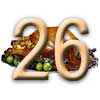 |
Turkey Safety Tips. When thawing your turkey in the refrigerator, allow 24 hours for every 5 pounds the bird weighs. Cook the turkey in an oven set no lower than 325 degrees Fahrenheit. Check internal cooking temperatures to assure proper doneness, stuffing inside the cavity should reach 165 degrees and the bird is done when the innermost thigh reaches 180 degrees. Juice should run clear. |



























